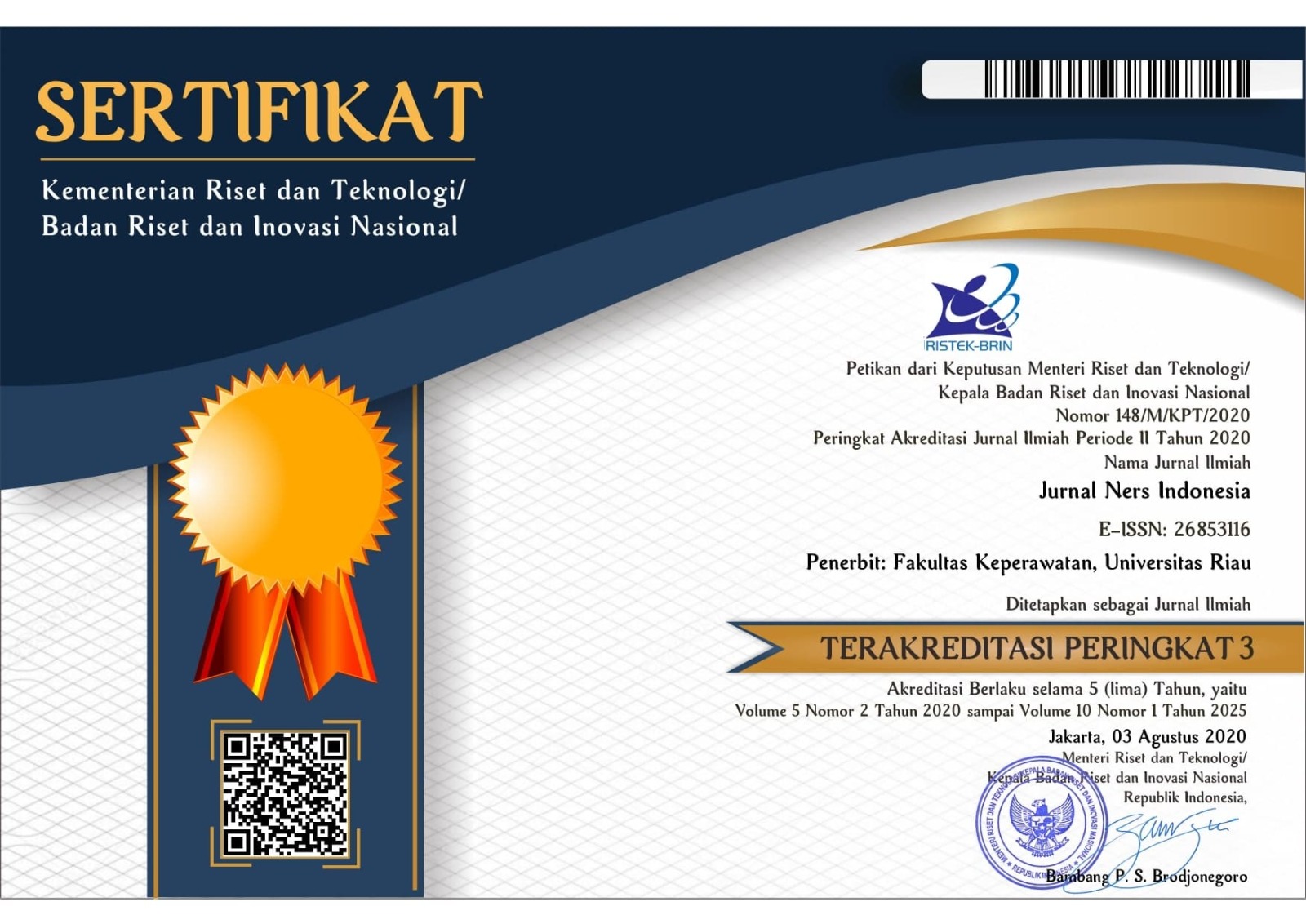FAKTOR INTRINSIK DAN EKSTRINSIK YANG MEMPENGARUHI TINDAKAN IBU HAMIL MELAKUKAN VAKSIN COVID-19
DOI:
https://doi.org/10.31258/jni.13.2.169-177Keywords:
pregnant women, covid-19 vaccine, perception, family support, health worker information, social media informationAbstract
The achievement of COVID-19 vaccination for pregnant women in Riau Province is still relatively low. Many factors influence pregnant women not to get the vaccine, both internal and external factors. This study aims to identify intrinsic and extrinsic factors that influence pregnant women's actions in carrying out the COVID-19 vaccination. The research design used is a cross-sectional study approach that simultaneously measures and collects the independent and dependent variables found in the research object. This research was conducted in the working area of the Umbansari Rumbai Public Health Center, Pekanbaru City. The population in this study was all pregnant women in the working area of the Umbansari Health Center for the period December 2021 to July 2022. The sampling technique in this study was purposive sampling with inclusion criteria: pregnant women in the second and third trimesters; mothers in good physical and mental health; pregnant women who live in the working area of the Umbansari Health Center. Based on this, the sample in this study amounted to 78 respondents. The statistical test used is the chi square, which is used to test whether or not there is an influence between the two variables. The results showed that the perceptions of pregnant women about the COVID-19 vaccine were balanced between positive and negative; information from health workers was adequate (60.3%); family support was low (73.1); and information from social media was negative (58.97). Statistical tests were obtained for perception (Pv = 0.005), information from health workers (Pv = 0.019), family support (Pv = 0.005), and information from social media (Pv = 0.039). Conclusion: Both intrinsic and extrinsic factors have been proven to influence pregnant women to get the COVID-19 vaccine. Suggestion: Health workers are more intense in providing information about the COVID-19 vaccine through social media.
References
Aisyah, Nur, Relasi Gender dalam Institusi Keluarga (Pandangan Teori Sosial Dan Feminis), Muwazah, Volume 5, Nomor 2, Desember 2013.
Ampofo, A. A. (2001). “When men speak women listen”: Gender socialisation and young adolescents’ attitudes to sexual and reproductive issues. African Journal of Reproductive Health, 5, 196-212.
Azisah S., dkk. (2016). Kontekstualisasi Gender, Islam Dan Budaya. Makasar: UIN Alauddin. Bidang Statistik dan Persandian Kota Pekanbaru. (2020). Data Statistik Sektoral Kota Pekanbaru Th 2020. Pekanbaru: Dinas Komunikasi, Informatika, Statistik, Informatika dan Persandian.
BKKBN.(2002). Partisipasi Pria dalam Program KB dan KR. http://www.bkkbn.go.id. Diunduh pada tanggal 11 November 2021.
BKKBN. (2009) Faktor-faktor yang mempengaruhi rendahnya partisipasi laki-laki dalam KB. http://www.bkkbn.go.id/gemalaki-laki/info detail.php?infid=79,200. Diunduh pada tanggal 8 november 2021.
Bunyamin B. (2015). Isu gender dalam program keluarga berencana. Jurnal Parallela:Vol.1(2). https://r.search.yahoo.com/_ylt=Awr9IlTv2ZxhRUgARDJXNyoA;_ylu=Y29sbwNncTEEcG9zAzMEdnRpZAMEc2VjA3Ny/RV=2/RE=1637698160/RO=10. Diunduh pada tanggal 12 November 2021.
Fakih, Mansour. (2013). Analisis Gender & Transformasi Sosila. Yogyakarta: Pustaka Pelajar.
Hariastuti. (2008). Strategi pembangunan KB berbasis masyarakat sebagai upaya pembangunan Keluarga Berencana di Jawa Timur. Diakses dari https://jurnal. ugm.ac.id/ pada tanggal 12 April 2021
Hidayat A.A. (2014). Metode Penelitian Kesehatan Paradigma Kuantitatif, Jakarta: Health Books
Kemenko PMK. (2020). Perkuat Pelaksanaan Program KB dan Kesehatan Reproduksi. https://www.kemenkopmk.go.id/perkuat-pelaksanaan-program- kb-dan-kesehatan-reproduksi. Diunduh pada tanggal 15 April 2021.
Kementerian Pemberdayaan Perempuan Dan Perlindungan Anak RI. (2021). Glosary Gender. https://www.kemenpppa.go.id/index.php/page/view/20. Diunduh pada tanggal 15 Apeil 2021.
Lasmita, Y., Misnaniarti, M., & Idris, H. (2021). Analisis Penerimaan Vaksinasi Covid-19 Di Kalangan Masyarakat. Jurnal Kesmas (Kesehatan Masyarakat) Khatulistiwa, 8(4), 195. https://doi.org/10.29406/jkmk.v8i4.3056
Mosha et al.(2013). Family planning decisions, perceptions and gender dynamics among couples in Mwanza, Tanzania: a qualitative study. https://bmcpublichealth.biomedcentral.com/articles/10.1186/1471-2458-13-523. Diunduh pada tanggal 11 November 2021.
Onyango, M. A., Owoko, S., & Oguttu, M. (2010). Factors that influence male involvement in sexual and reproductive health in western Kenya: A qualitative study. African Journal of Reproductive Health, 14(Spec No. 4), 32-42.
Pengarusutamaan Gender Bidang Politik, Sosial Dan Hukum Kementerian Pemberdayaan Perempuan Dan Perlindungan Anak. (2016). Parameter Kesetaraan Gender Dalam Pembentukan Peraturan Perundang-Undangan. Jakarta.
Sarwono S.W. (2017). Teori-teori psikologi social. Edisi 19. Jakarta: Rajawali Pers
Sternberg, P., & Hubley, J. (2004). Evaluating men’s involvement as a strategy in sexual and reproductive health promotion. Health Promotion International, 19, 389-396. doi:10.1093/heapro/dah312
Suryaningrum M.A. (2020). Peran Gender Dalam Ber-Kb. https://www.bkkbn.go.id/detailpost/peran-gender-dalam-ber-kb. Diunduh pada tanggal 15 April 2021.
Tukiran, Pitoyo, Agus Joko dan Kutanegara, Pande Made, eds. (2010). Keluarga Berencana & Kesehatan Reproduksi. Yogyakarta: Pustaka Pelajar.
Utomo, dkk. (2015). Kesehatan reproduksi di Indonesia, Situasi dan Tantangan, 2015, Jaringan Epidemiologi Nasional, Population Council.
Zhu, B. Y., Bu, J., Huang, P. Y., Zhou, Z. G., Yin, Y. P., Chen, X. S., . . .Gan, Q. (2012). Epidemiology of sexually transmitted infections, HIV, and related high-risk behaviors among female sex workers in Guangxi Autonomous Region, China. Japanese Journal of Infectious Diseases, 65(1), 75-78Prematur. Padjadjaran Nursing Journal, 5(3).












